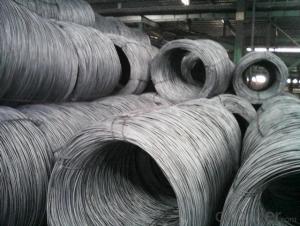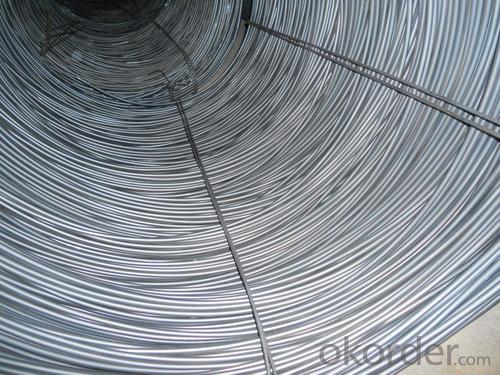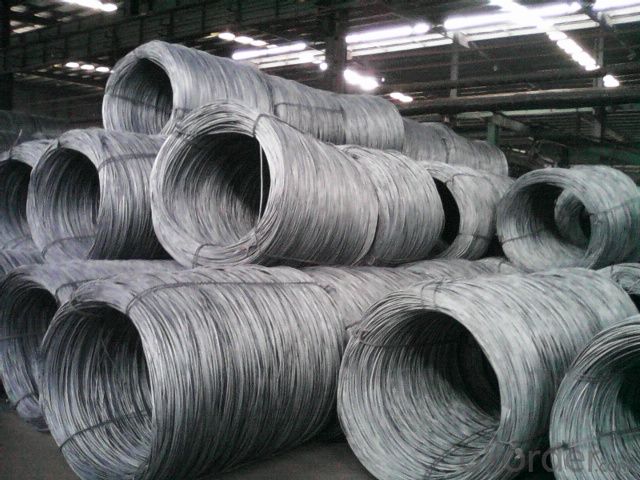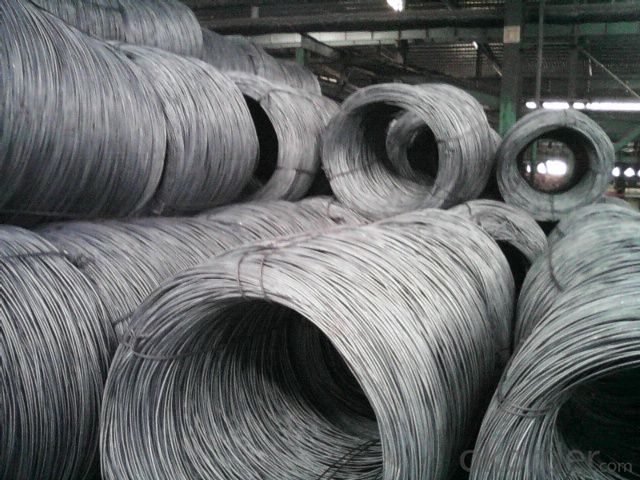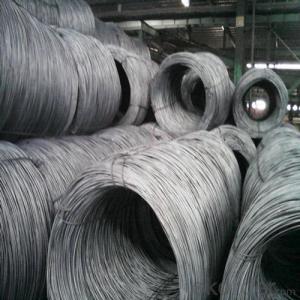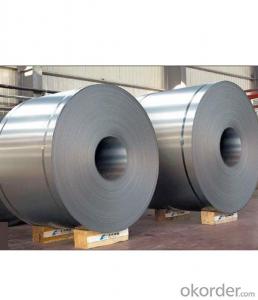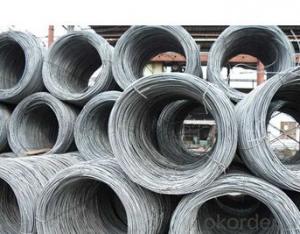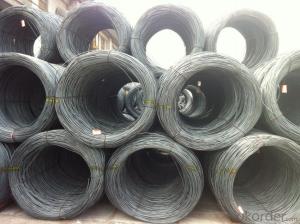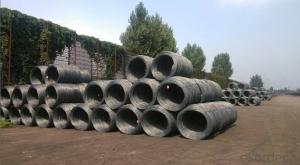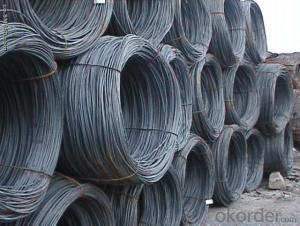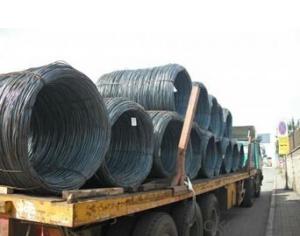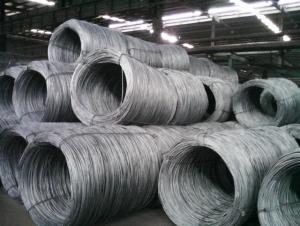Hot Rolled Carbon Steel Wire Rod
- Loading Port:
- Tianjin
- Payment Terms:
- TT OR LC
- Min Order Qty:
- -
- Supply Capability:
- 200000 m.t./month
OKorder Service Pledge
OKorder Financial Service
You Might Also Like
Specifications of Hot Rolled Carbon Steel Wire Rod:
Steel Grade: Q195/235, SAE1006-1018B Standard: ASTM, GB
Diameter: 5.5mm, 6.5mm, 7mm,8mm,9mm,10mm,12mm,14mm
Diameter tolerance: ±0.3mm Type: in coil, coil weight around 2MT
Technique: Hot Rolled Place of Origin: China Mainland
Surface: round, no twisted, light and smooth Brand Name: HSKY
Chemical Composition: (Please kindly find our chemistry of our material based on Q195、Q235A and Q235B as below for your information)
Trademark | Rank | Chemical composition (quality score) % | |||||
C | Si | Mn | S | P | |||
| ≤ |
| ≤ | ≤ | |||
Q195 |
| 0.06-0.12 | 0.30 | 0.25 | 0.050 | 0.045 | |
Q235 | A | 0.14-0.22 | 0.30 | 0.30-0.65 | 0.050 | 0.045 | |
Q235 | B | 0.12-0.20 | 0.30 | 0.30-0.70 | 0.045 | 0.045 | |
Trademark | Rank | Pulling Test | |||||
Bend PointΔs/Mpa | Tensile Strength | Elongation Ratioδ5% | |||||
Thickness (Diameter) /MM | Thickness (Diameter) /MM | ||||||
≤16 | 16-40 | ≤16 | 16-40 | ||||
≥ | ≥ | ||||||
Q195 |
| 195 | 185 | 315-390 | 33 | 32 | |
Q235 | A | 235 | 225 | 375-500 | 26 | 25 | |
Q235 | B | 235 | 225 | 375-500 | 26 | 25 | |
Usage and Applications of Hot Rolled Carbon Steel Wire Rod:
After hot-rolled the products shaped into coil and delivery as finished product, including round, square, rectangular, hexagonal and so on. Since most of the products are round, it is generally called wire rod. Carbon steel wire rod is widely used in construction and manufacturing. Carbon steel wire rod is mainly used for reinforcement of reinforced concrete and welded structure or reprocessed (roberts , nail, etc.) materials, especially used to produce wire drawing, welding electrode, nails, spring, electronic, precise machinery parts and so on.
Packaging & Delivery of Hot Rolled Carbon Steel Wire Rod:
Packaging Detail: products are packed in coil, each coil weight around 2 MT, and then shipped by container or bulk vessel
Delivery Detail: within 45 days after received deposit or LC.
Label: to be specified by customer, generally, each bundle has 1-2 labels
Trade terms: FOB, CFR, CIF
Carbon Steel Wire Rod on Port
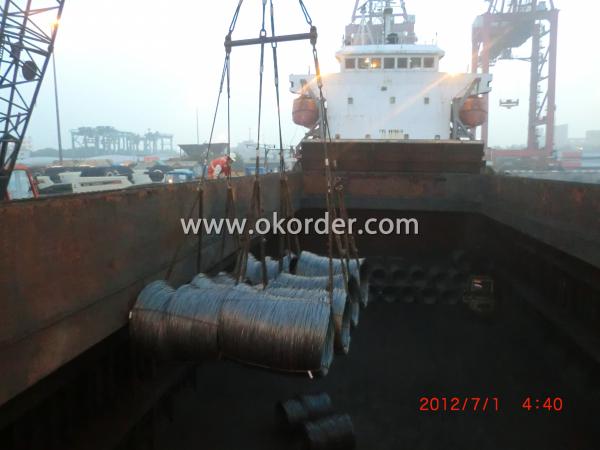
Carbon Steel Wire Rod in Container
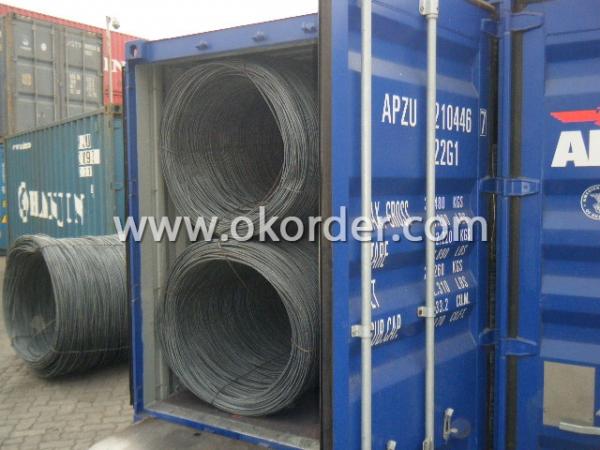
Note:
1. Our products are produced according to national standard (GB), if not, supply according to national standards (GB) or agreement as customer required.
2. Other Grade and Standard carbon steel wire rod we can supply:
Grade:H08A, 30MnSi, 62B-82B
Standard: AISI, BS, JIS, DIN
The Minimum Order Quantity of these products is high, and need to be confirmed.
3. We can not only supply carbon steel wire rod; if you need anything about building materials, please contact us.
4. Please send us your detail specifications when inquire. We will reply to you as soon as possible.We sincerely hope we can establish a long stable business relationship.
- Q: How is the surface finish of steel wire rod determined?
- The surface finish of steel wire rod is determined through a combination of manufacturing processes and quality control measures. First, the steel wire rod is produced through a hot rolling process, where the steel is heated and passed through a series of rollers to achieve the desired shape and thickness. During this rolling process, the surface of the steel wire rod can develop imperfections such as scale, which is a layer of oxide that forms on the surface due to the high temperatures involved. To remove this scale and improve the surface finish, the steel wire rod may undergo a descaling process, which involves methods like acid pickling or mechanical descaling. After descaling, the steel wire rod may undergo further processes like cold drawing or heat treatment to achieve the desired mechanical properties. These additional processes can also contribute to improving the surface finish of the steel wire rod. To ensure the desired surface finish is achieved, quality control measures are implemented throughout the manufacturing process. This includes regular inspections and testing of the steel wire rod to detect any surface defects or imperfections. Various techniques such as visual inspection, ultrasonic testing, and surface profilometry can be used to evaluate the surface finish and ensure it meets the required standards. In conclusion, the surface finish of steel wire rod is determined through a combination of manufacturing processes such as rolling, descaling, cold drawing, and heat treatment. Quality control measures are also implemented to inspect and test the surface finish, ensuring it meets the desired standards.
- Q: How is steel wire rod coated for corrosion protection?
- Various methods are commonly employed to coat steel wire rods for corrosion protection. One such method involves the utilization of hot-dip galvanizing, where the wire rod is passed through a bath of molten zinc at a temperature of approximately 450 degrees Celsius. By doing so, the zinc coating effectively adheres to the surface of the wire rod, serving as a safeguard against corrosion. Another approach is electroplating, which entails immersing the wire rod in an electrolyte solution that contains zinc ions. Subsequently, an electric current is passed through the solution, leading to the bonding of the zinc ions with the wire rod's surface. This process engenders a uniform and long-lasting zinc coating that confers protection against corrosion. Furthermore, organic coatings such as paint or polymer coatings can be applied to wire rods. These coatings are administered through methods like spraying, dipping, or electrostatic deposition. By establishing a barrier between the steel wire rod and its surroundings, the organic coatings obstruct moisture and other corrosive agents from reaching the surface, thus averting corrosion. In summary, the choice of coating process for steel wire rods hinges upon specific requirements and intended applications. Factors such as the desired level of corrosion resistance, prevailing environmental conditions, and the wire rod's aesthetic preferences all contribute to determining the most suitable coating method.
- Q: How is steel wire rod used in the manufacturing of wire forms for pet enclosures?
- Steel wire rod is an essential component in the manufacturing of wire forms for pet enclosures. This type of rod is typically made from high carbon steel, which provides excellent strength and durability. To create wire forms for pet enclosures, the steel wire rod is first processed through a series of machines that stretch and shape it into the desired wire thickness and length. This process, known as drawing, ensures that the wire is uniform and free from defects. Once the wire is ready, it is then bent and formed into various shapes and sizes to create the wire forms for pet enclosures. These wire forms can include panels, gates, and frames that are used to construct the enclosure. The use of steel wire rod in the manufacturing of wire forms for pet enclosures offers several benefits. Firstly, steel is a highly durable material that can withstand the wear and tear associated with pet activities. It is also resistant to rust and corrosion, ensuring that the wire forms remain in good condition even when exposed to various weather conditions. Additionally, steel wire rod provides the necessary strength and stability required to secure pets within the enclosures. This is crucial for ensuring the safety and security of the animals. The rigidity of the steel wire prevents pets from breaking or bending the wire forms, keeping them contained and protected. Furthermore, the versatility of steel wire rod allows for customization and flexibility in the design of wire forms. Manufacturers can create wire forms in different shapes, sizes, and configurations to cater to the specific needs of pet owners and their pets. In conclusion, steel wire rod plays a vital role in the manufacturing of wire forms for pet enclosures. Its strength, durability, and versatility make it an ideal material for creating secure and long-lasting enclosures for pets.
- Q: What is the chemical composition of steel wire rod?
- The chemical composition of steel wire rod typically includes iron, carbon, manganese, silicon, and small amounts of other elements such as sulfur and phosphorus.
- Q: What is the pricing structure of steel wire rod?
- The pricing structure of steel wire rod varies based on several factors such as the quality of the steel, market demand, production costs, and global economic conditions. It is typically determined by market forces and can fluctuate over time.
- Q: How is the inclusion content of steel wire rod determined?
- The inclusion content of steel wire rod is determined through various methods and techniques. One common approach is the use of microscopic analysis, where a sample of the wire rod is examined under a microscope to identify and quantify the inclusions present. The sample is typically prepared by cutting a small section of the wire rod and mounting it on a microscope slide. This allows for a clear and detailed view of the inclusions. The sample is then polished and etched to reveal the inclusions more clearly. Under the microscope, the inclusions can be categorized based on their size, shape, and composition. They can range from small particles to larger clusters, and can be identified as oxides, sulfides, or other types of impurities. Quantifying the inclusion content involves counting the number of inclusions present in a given area or volume of the sample. This can be done manually by counting each inclusion, or by using automated image analysis software that can detect and count the inclusions. In addition to microscopic analysis, other techniques such as scanning electron microscopy (SEM) and energy-dispersive X-ray spectroscopy (EDS) can be employed to further analyze the inclusions and determine their elemental composition. The inclusion content of steel wire rod is an important quality parameter, as excessive inclusions can negatively affect the mechanical properties and performance of the final product. Therefore, accurate determination of the inclusion content is crucial for ensuring the quality and reliability of the steel wire rod.
- Q: What are the different steelmaking processes used for steel wire rod production?
- There are primarily three steelmaking processes used for steel wire rod production: the electric arc furnace (EAF) process, the basic oxygen furnace (BOF) process, and the open hearth furnace (OHF) process. The EAF process involves melting scrap steel in an electric arc furnace and then refining it to produce wire rod. The BOF process involves blowing oxygen onto the molten iron in a basic oxygen furnace to remove impurities and produce steel wire rod. The OHF process, although less common nowadays, involves heating the raw materials in an open hearth furnace to produce steel wire rod.
- Q: How does the yield strength of steel wire rod vary with different grades?
- The yield strength of steel wire rod can vary significantly with different grades. Steel wire rod is produced in various grades, each with its own unique composition and heat treatment process. The yield strength refers to the amount of stress a material can withstand before it begins to deform permanently. Different grades of steel wire rod are designed to have specific mechanical properties to meet the requirements of different applications. Generally, higher grades of steel wire rod have higher yield strengths. This is achieved by adjusting the chemical composition and heat treatment processes during manufacturing. For example, low carbon steel wire rod grades typically have lower yield strengths and are commonly used in applications where flexibility and ductility are important, such as in wire mesh and fencing. On the other hand, high carbon steel wire rod grades are known for their high yield strengths and are used in applications that require greater strength and durability, such as in automotive parts and construction materials. The yield strength of steel wire rod can also be influenced by other factors such as the size and shape of the rod, the presence of alloying elements, and the manufacturing process. It is important to consider these factors when selecting the appropriate grade of steel wire rod for a specific application to ensure optimal performance and safety.
- Q: How is steel wire rod recycled?
- Steel wire rod is typically recycled through a process called electric arc furnace (EAF) steelmaking. First, the steel wire rod is collected from various sources, such as scrap metal yards or manufacturing plants. It is then cleaned and sorted to remove any contaminants. Next, the wire rod is melted down in an electric arc furnace, where high temperatures and an electric current are used to melt the steel. Once melted, impurities are removed, and the molten steel is refined to achieve the desired composition. Finally, the molten steel is cast into new wire rod shapes or other steel products, completing the recycling process.
- Q: What are the different international specifications for steel wire rod?
- Steel wire rod must meet specific requirements and characteristics outlined in various international specifications. Commonly used specifications include ASTM A510, EN 10016-2, JIS G 3505, GB/T 699, and ISO 16120-4. These standards cover carbon steel wire rods, non-alloy steel rods, low carbon steel wire rods, and general requirements for steel wire rod. Additionally, industry-specific standards and customer requirements may exist for specific applications. Consulting the relevant specifications is crucial to ensure compliance and meet application needs.
Send your message to us
Hot Rolled Carbon Steel Wire Rod
- Loading Port:
- Tianjin
- Payment Terms:
- TT OR LC
- Min Order Qty:
- -
- Supply Capability:
- 200000 m.t./month
OKorder Service Pledge
OKorder Financial Service
Similar products
Hot products
Hot Searches
Related keywords


